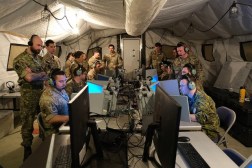Pentagon extends ADA effort to accelerate combatant commands’ AI adoption

Pentagon leadership officially moved to extend the exploratory effort that’s embedding Chief Digital and Artificial Intelligence Office personnel within every combatant command to coordinate and integrate data across all military systems, applications and users through fiscal year 2029.
The AI and Data Acceleration initiative — or ADA, in homage to computer programming pioneer Ada Lovelace — was originally a three-year effort funded through fiscal 2024, when Deputy Defense Secretary Kathleen Hicks first unveiled it in 2021.
While the exact requested amount for ADA in the president’s budget request for fiscal 2025 remains unclear, according to two senior officials who briefed DefenseScoop recently, the Defense Department has opted to keep the program running at least through fiscal 2029, or the end of the Future Years Defense Program.
“I think this is a journey. We’ve made incredible progress, but it’s not going to be done [this year]. And so having that right talent out there to constantly be responsive and aware of their needs is a great thing for the department,” the Pentagon’s Deputy Chief Digital and AI Officer Margie Palmieri said in an interview.
‘Where’s my stuff?’
ADA’s roots trace back to before Hicks in 2021 formed the CDAO, combining teams of officials from the Pentagon’s former Joint Artificial Intelligence Center, Defense Digital Service, Office of the Chief Data Officer, Project Maven and the Advana program within one new hub to strategically accelerate data-sharing and AI adoption.
Palmieri noted that inspiration for the ADA initiative came from discussions that participants across those organizations were having back then about how to best equip the military’s combatant commands with technological expertise and assets.
“The idea was that we would put one civilian [Government Schedule or GS-15] at each combatant command, and then provide core support to them through department initiatives,” she explained.
After that step, though, “it really took about two years to get all those leads in place — by the time we went through the hiring process and found the right folks who were willing to go live at the combatant commands out across the globe,” Palmieri said.
Early on, the CDAO leads found that each of the commands was functioning at very different stages of maturation in their paths toward being fully data-driven and were not applying resources in a standard way. However, officials did see a trend in requests for assistance associated with the DOD’s centralized data and analytics platform, Advana.
Recent budget documents refer to Advana as “a technology platform that not only houses a collection of enterprise data, but expands the boundaries of a standard data warehouse by arming military and business decision-makers with decision support analytics, visualizations, and data tools.”
Putting it another way, Palmieri said: “It is a collection of capabilities that, when they come together, give you the power of data analytics. At its core it is a data hub — I’ll call it a hub, it’s kind of a data catalog — so it tells you where all the data is in the department.”
Quickly, leadership across the combatant commands was broadly interested in using data to inform the readiness of the personnel and logistics elements of their operations.
“A lot of them just really want to know where their people are. What’s the readiness status? Where are they with operations and exercises and support? What does security force assistance look like inside of their combat command? So, a lot of things that had been done through data calls or through PowerPoint. But doing this in Advana gave us a kind of coherent, CoCom-wide view or department-wide view,” Palmieri explained.
“It’s one thing to have the raw data; it’s another thing to be able to make sense of that data in a way that can be presented to decision-makers,” she added.
In her view, the fast-moving, modern technology landscape — and top U.S. priorities like Joint All-Domain Command and Control — are forcing the department to no longer silo what was previously considered business versus warfighting data.
“In reality, personnel readiness, logistics, the status and positioning of forces, it’s stuck in the middle. It’s neither business nor warfighting. It’s both,” Palmieri said.
The CDAO’s senior representative embedded at U.S. Indo-Pacific Command, Dan Tadevich, also recognizes an ongoing transformation.
“There’s a cartoon that I really like. It’s called the blind men and the elephant. If you can visualize this picture of an elephant, and all of us sitting around the table are touching a different part of the elephant. So all that we know is what we’re touching, instead of the fact that there’s an elephant there that you’re trying to get a picture of. In my mind, that’s very illustrative of what we try to do,” he told DefenseScoop during the interview alongside Palmieri.
“You take the logistics work, and you take the operational work, you take all these other pieces, but then you all come together as an operational planning group or planning team, put all your information on the table and you come up with a plan. And so that’s what we did at Indo-Pacom, and that’s what the ADA teams are out there really doing, is helping everybody get access to the data in a much more streamlined and expeditious way — so that you can build those visualizations and things that help you understand the elephant that you’re trying to see,” he explained.
As that bigger picture all comes together, the aim is that military leaders at each command can make high-stakes choices faster and based on more accurate information.
“When everybody is sitting around the table talking about how to execute something, [it starts with] ‘Where’s my people? Where’s my stuff? What can I do with it? And who’s ready to act now?’ So, if you can answer those initial questions, then the people sitting around the table can now start making the decisions and laying out the puzzle pieces in a way, and they give you the picture of what we can do today. Because that’s really what the leadership and the boss want to know,” Tadevich said.
He and the CDAO’s other combatant command embeds catch up on weekly calls and daily in informal chat rooms to share updates on their progress and ideas for integration or opportunities to share in-development and existing resources.
Among other responsibilities, the ADA officials are also conducting digital readiness assessments on each command.
When asked which command demonstrated that they were the most “digitally ready”
at this time, Palmieri and Tadevich both pointed to U.S. Transportation Command.
“They have been tested through fire. The [Afghan non-combatant evacuation operation or NEO] — how do you get people in and out of Afghanistan? The Ukraine support in terms of how are you going to move equipment all over the place? And [the COVID-19 pandemic] actually was a big Transcom challenge,” Palmieri said.
The next chapter
“You won’t see an ADA line inside of our core CDAO budget,” the deputy CDAO noted, pointing out that the undisclosed total comes from several different “pots of money.” But again, Palmieri confirmed that — as part of a recent, overarching restructure of the CDAO’s budget — senior DOD leaders have formally initiated plans to extend CDAO support at the commands via ADA through fiscal 2029.
Palmieri and other CDAO officials did not share the exact number for requested or planned ADA funding (in or after 2025) before publication.
One thing that news of this ADA extension does provide, though, is the chance for current ADA embeds like Tadevich to be hired in “permanent” roles — instead of their current three-year temporary billets.
“That’s been one of the worries, that the three years is coming up. Whether the commands had taken the proper steps to be organically self-sufficient or not, doesn’t really matter — except for if it was going to go away — then it’s a problem, right? So the fact that [the Office of the Secretary of Defense] recognizes that all the commands didn’t move equally, and then they’re committing to continue to help and provide resources and to be that bridge to the next step is, I think, the most important thing that comes out of this,” Tadevich told DefenseScoop.
Now, he and other CDAO officials are preparing to steer what they hope will be a new wave of ADA-driven progress.
“I think the next chapter is we see a lot of value being connected to the combatant commands and their data needs. So having that CDAO rep at the combatant commands that can reach back to make sure that we’re providing the best support to our senior-most military commanders and decision-makers in the field is 100% where we want to be,” Palmieri said.
“The next question is — that’s one person — and we have some resources in the CDAO budget, but ADA was created to really figure out what we want to do is the department in supporting data-enabled decision-making inside the combatant commands,” she added. “And so through our normal budget processes, we’ve heard from a bunch of combatant commands about how they want to grow their teams, about how they want more resources, and more applications to use. They’re really excited to grow this mission space. So our next step in the CDAO is to get a sense of what that should look like for the department.”






